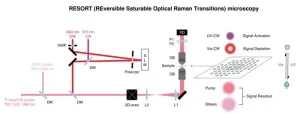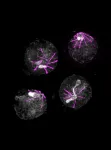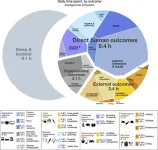(Press-News.org) Cedars-Sinai investigators have identified several steps in a cellular process responsible for triggering one of the body’s important inflammatory responses. Their findings, published in the peer-reviewed journal Science Immunology, open up possibilities for modulating the type of inflammation associated with several infections and inflammatory diseases.
Specifically, the investigators have improved understanding of the steps that lead to the production of IL-1 beta, a potent inflammatory protein signal released during many inflammatory responses.
“We now have a clearer understanding of the stepwise process that leads to the production of IL-1 beta,” said Andrea Wolf, PhD, assistant professor of Biomedical Sciences and Medicine at Cedars-Sinai, and a senior and corresponding author on the new study. “By understanding the process, we hope to one day find a treatment for diseases associated with this inflammatory response.”
When the innate immune system—the defense system we were born with—identifies a potentially harmful bacterium, virus, or other external invader, it unleashes white blood cells to surround and attack the foreign agent. This can cause swelling, redness, heat and pain in the body’s tissues that—in a healthy body—eventually go away.
Some people, however, get stuck in the inflammation phase. This causes what is known as chronic inflammation. Chronic inflammation can damage healthy cells in the body and is thought to lead to serious conditions like Type 2 diabetes, heart disease and depression.
“Inflammation, in many instances, is vital to a thriving immune system and healthy body,” said David Underhill, PhD, chair of the Department of Biomedical Sciences and the Janis and William Wetsman Family Chair in Inflammatory Bowel Disease, who is also a senior and corresponding author on the study. “However, prolonged inflammation can wreak havoc on the body. This underscores the importance of understanding the cellular process of how inflammation is activated so we can work toward finding new treatments to curb chronic inflammation.”
The study published today is a follow-up to Cedars-Sinai research published in 2016 that explains how cells act to detect an infection. In that study, investigators discovered that an enzyme called hexokinase, typically used by cells to convert glucose into energy, has a second, inflammatory function. They discovered that hexokinase binds to a sugar from the cell wall of bacteria and activates the inflammasomes, leading to the production of IL-1 beta. Inflammasomes are receptors of the innate immune system that recognize microbes and tissue damage.
The current work presents a more complete picture of this process.
The investigators discovered that hexokinase leaves the mitochondria, the part of a cell that generates energy. This jump-starts an immune response: The release of hexokinase destabilizes the mitochondria and alerts the cell that something is wrong. This leads to clustering of a channel called VDAC in the membrane of the mitochondria, which interacts with another protein called NLRP3 to initiate inflammasome assembly. The inflammasomes then produce IL-1 beta, a driver of inflammation.
Investigators studied cells that were derived from laboratory mice to understand the steps involved in the IL-1 beta pathway. The team used substances called inhibitors that block cellular functions as well as gene-editing technology to turn off certain genes and the proteins they express. This allowed them to understand which proteins are vital to triggering inflammation.
Cedars-Sinai postdoctoral scientist Sung Hoon Baik, PhD, used the super-resolution microscope that is part of the Cedars-Sinai Biobank and Research Pathology Resource to visualize and measure the steps of this inflammatory process within individual cells.
“Being able to target specific steps in this pathway is vital, because in addition to being important for inflammation, the components of this pathway also play a vital role in maintaining energy within the cell,” Wolf said. “We want to home in on its inflammatory role, not just turn it all off, because that would be bad for the cell.”
The investigators are continuing to study the cellular steps leading up to, and resulting from, hexokinase’s role in the activation of inflammasomes. They are also using the results from this study to begin to target this inflammatory pathway in different diseases.
Other Cedars-Sinai investigators who worked on the study include Courtney Becker, manager of the Underhill Laboratory at Cedars-Sinai; Sarah Fett, research associate at Cedars-Sinai; and V. Krishnan Ramanujan, PhD, research associate professor in the Department of Medicine at Cedars-Sinai and director of the Cedars-Sinai Biobank.
Funding: The study was funded by the National Institutes of Health (award numbers R01AI148465, R01GM085796, R01AI071116).
END
Uncovering a cellular process that leads to inflammation
Cedars-Sinai investigators say data point to new drug targets in an important inflammatory pathway related to multiple diseases
2023-06-16
ELSE PRESS RELEASES FROM THIS DATE:
New imaging technique is no last resort
2023-06-16
There are various ways to image biological samples on a microscopic level, and each has its own pros and cons. For the first time, a team of researchers, including those from the University of Tokyo, has combined aspects from two of the leading imaging techniques to craft a new method of imaging and analyzing biological samples. Its concept, known as RESORT, paves the way to observe living systems in unprecedented detail.
For as long as humanity has been able to manipulate glass, we have used optical devices to peer at the microscopic world in ever increasing ...
Abnormalities in neurodevelopment could lay the foundations for Alzheimer’s disease
2023-06-16
In the cerebral cortex, neurogenesis – the formation of neural cells from stem cells – begins in the fetus from 5 weeks gestation and is almost complete by 28 weeks. It is a complex process with finely tuned mechanisms. “In humans, neurogenesis lasts particularly long compared with other species, explains Khadijeh Shabani, a post-doctoral researcher at Paris Brain Institute. Neural stem cells remain in a progenitor state for an extended period. Only later do they differentiate into glial cells, astrocytes, or oligodendrocytes that will form the architecture of the brain and spinal cord.”
Until ...
Disorient the malaria parasite to prevent it from causing harm
2023-06-16
With almost 250 million cases a year, 621,000 of them fatal, malaria remains a major public health problem, particularly in sub-Saharan Africa. Malaria is a parasitic disease transmitted by mosquitoes and caused by a microbe of the genus Plasmodium. On its journey from mosquito to human, Plasmodium must adapt to the specificities of the many organs and cells it parasitizes. Microbes do not have sensory organs; instead, they have sensors made of proteins to detect molecules specific to the environments they colonize. While most living organisms share the same types of sensors, Plasmodium is an exception. Biologists at the University of Geneva (UNIGE) have identified a new type ...
Growing number of hypothyroidism patients receiving treatment other than levothyroxine
2023-06-16
The use of thyroid hormones other than the commonly prescribed hormone medicine levothyroxine to treat hypothyroidism, or underactive thyroid, is increasing, according to a study being presented Friday at ENDO 2023, the Endocrine Society’s annual meeting in Chicago, Ill.
“This is significant because the long-term health outcomes of these treatments are not as well known as levothyroxine,” said researcher Matthew Ettleson, M.D., of the University of Chicago in Chicago, Ill.
The thyroid makes the hormones triiodothyronine ...
Prevalence of metabolic associated fatty liver disease is increasing
2023-06-16
CHICAGO—The percent of metabolic associated fatty liver disease (MAFLD), the leading global cause of liver disease, is increasing in U.S. adults, according to a study presented Friday at ENDO 2023, the Endocrine Society’s annual meeting in Chicago, Ill.
Mexican Americans consistently had the highest percentage of MAFLD, especially in 2018, although the prevalence of increase was higher among Whites, the study found.
MAFLD, previously known as non-alcoholic fatty liver disease (NAFLD), is fast becoming the most common indication ...
The global human day – A bird’s eye perspective
2023-06-16
Everyone has 24 hours per day. Across the global population of 8 billion people this adds up to approximately 190 billion human hours per day. How those hours are spent determines the impacts we have on our surroundings as well as how we experience life. To find out how people around the world use their time, a research team led by McGill University has gathered and analyzed information about both economic and non-economic activities in order to estimate, for the first time, what a day in the life of the world looks like.
“At present, we are struggling to come to terms with global challenges, and that calls for fresh perspectives on how the world ...
Planned reform of EU pharmaceutical legislation: early market access and robust evidence need not be a contradiction
2023-06-16
The European Commission's stated aim is to improve access to innovative drugs at the national level throughout the EU. Firstly, according to the proposal for the reform of EU pharmaceutical legislation, there are still considerable differences in access between countries. Secondly, drug development has so far only been geared to a limited extent to the actual needs of patients. According to the German Institute for Quality and Efficiency in Health Care (IQWiG), the latter point is in line with the perspective of the ...
Dads are key in supporting breastfeeding, safe infant sleep
2023-06-16
Findings highlight racial disparities in sudden unexpected infant death in the U.S.
Only 16% fathers followed all three AAP-recommended infant sleep practices
Rates of breastfeeding initiation and breastfeeding at eight weeks were much higher among fathers who wanted their infant’s mother to breastfeed than those who did not or had no opinion
CHICAGO --- Fathers can make a huge difference in whether an infant is breastfed and placed to sleep safely, according to a recent survey of new fathers led by scientists at Northwestern University and the Ann & Robert H. Lurie Children’s Hospital of Chicago.
The study included 250 fathers who ...
AI could replace humans in social science research
2023-06-16
In an article published yesterday in the prestigious journal Science, leading researchers from the University of Waterloo, University of Toronto, Yale University and the University of Pennsylvania look at how AI (large language models or LLMs in particular) could change the nature of their work.
“What we wanted to explore in this article is how social science research practices can be adapted, even reinvented, to harness the power of AI,” said Igor Grossmann, professor of psychology at Waterloo.
Grossmann and colleagues note ...
Research hints at how fungus farming ants keep their gardens healthy
2023-06-16
‘Weed early and often’ is the key to a productive garden. Interestingly, certain species of ants are also avid gardeners, a practice they’ve refined over 50 million years. They too weed their underground fungus gardens, but how they know what to weed out has been a mystery. Now, a multidisciplinary team of scientists report in PNAS on June 15 how ants distinguish the good fungus from the bad.
People rely on sight to identify weeds but ants grow fungus underground in the dark and must have other ways to sense undesirable garden denizens. A team led by Jonathan Klassen, Ph.D., at the ...
LAST 30 PRESS RELEASES:
Securing AI systems against growing cybersecurity threats
Longest observation of an active solar region
Why nail-biting, procrastination and other self-sabotaging behaviors are rooted in survival instincts
Regional variations in mechanical properties of porcine leptomeninges
Artificial empathy in therapy and healthcare: advancements in interpersonal interaction technologies
Why some brains switch gears more efficiently than others
UVA’s Jundong Li wins ICDM’S 2025 Tao Li Award for data mining, machine learning
UVA’s low-power, high-performance computer power player Mircea Stan earns National Academy of Inventors fellowship
Not playing by the rules: USU researcher explores filamentous algae dynamics in rivers
Do our body clocks influence our risk of dementia?
Anthropologists offer new evidence of bipedalism in long-debated fossil discovery
Safer receipt paper from wood
Dosage-sensitive genes suggest no whole-genome duplications in ancestral angiosperm
First ancient human herpesvirus genomes document their deep history with humans
Why Some Bacteria Survive Antibiotics and How to Stop Them - New study reveals that bacteria can survive antibiotic treatment through two fundamentally different “shutdown modes”
UCLA study links scar healing to dangerous placenta condition
CHANGE-seq-BE finds off-target changes in the genome from base editors
The Journal of Nuclear Medicine Ahead-of-Print Tip Sheet: January 2, 2026
Delayed or absent first dose of measles, mumps, and rubella vaccination
Trends in US preterm birth rates by household income and race and ethnicity
Study identifies potential biomarker linked to progression and brain inflammation in multiple sclerosis
Many mothers in Norway do not show up for postnatal check-ups
Researchers want to find out why quick clay is so unstable
Superradiant spins show teamwork at the quantum scale
Cleveland Clinic Research links tumor bacteria to immunotherapy resistance in head and neck cancer
First Editorial of 2026: Resisting AI slop
Joint ground- and space-based observations reveal Saturn-mass rogue planet
Inheritable genetic variant offers protection against blood cancer risk and progression
Pigs settled Pacific islands alongside early human voyagers
A Coral reef’s daily pulse reshapes microbes in surrounding waters
[Press-News.org] Uncovering a cellular process that leads to inflammationCedars-Sinai investigators say data point to new drug targets in an important inflammatory pathway related to multiple diseases




